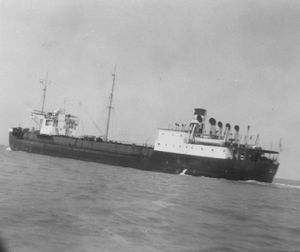Lake tanker
Lake Tankers were small, (about 6,000 ton), specially designed ships that carried the crude oil, pumped from beneath Lake Maracaibo in Venezuela, to the three off-shore refineries located on the Dutch islands of Aruba and Curacao. The entire operation of these refineries depended on the crude from Lake Maracaibo, and a fleet of these little tankers carried the crude from Lake Maracaibo, through the shallow cannel between Lake Maracaibo and the Caribbean Sea, to Aruba and Curaçao, Netherlands West Indies. Aruba had two refineries, Lago Oil & Transport Co. Ltd., owned by Standard Oil of New Jersey and Eagle, owned by Royal Dutch Shell. There was also a Royal Dutch Shell refinery on the island of Curaçao. All three refineries depended on their own fleet of Lake tankers to supply the crude for the refinery. The Lago refinery housed the officers and their families in Lago Colony, a community owned by the company which housed all their foreign staff employees. The Lake Tanker was a small vessel in comparison with the larger ocean going oil tankers; they have a very shallow draft with a flat bottom. This allowed this small ship to maneuver over the ever shifting sand bars that blocked the channel going into Lake Maracaibo. This shallow entrance into Lake Maracaibo from the Caribbean Sea prevented larger ships from entering the lake and thus the need for the smaller Lake Tanker. The first Lake Tankers were built in England in around 1923 and subsequent ships remained small until after World War II when, with the dredging of the channel to Lake Maracaibo the lake tankers became larger. The last Lake Tanker was retired from service in 1953, when the cannel from Lake Maracaibo to the sea was finely dredged and deepened to allow ocean-going tankers to enter the lake and pipelines from the lake were constructed to deep water ports in the Paraguana Peninsula.

